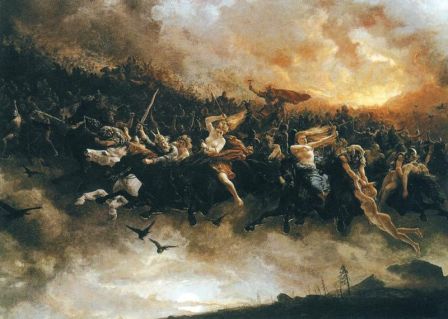
“Tanit, Ibicenco Godess” by Dominique Sanson
“Tanat’s themes are unity, joy and luck. Her symbols are flowers and triangles. In Cornwall, Tanat is the mother Goddess of fertility who has given all Her attention to nursing spring into its fullness. She also staunchly protects Her children (nature and people) so that our spirits can come to know similar fulfillment.
The Furry Dance is an ancient festival that rejoices in Tanat’s fine work manifested in spring’s warmth and beauty. To bring this Goddess’s lucky energy into your life, it’s customary to dance with a partner. In fact, the more people you can get dancing, the more fortunate the energy! Usually this is done on the streets throughout a town as a show of regional unity, but when propriety won’t allow such a display, just dance around a room together instead. Don’t worry about the steps – just do what feels right.
Wearing something with floral or triangular motifs (guys, wear a necktie, and gals, pull out a square scarf and fold it in half crosswise) activates Tanat’s happiness in your life and in any region where you have the token on today. As you don the item, say:
‘Liberate happiness in and around
by Tanat’s blossoming power
joy will be found!’
Or, if you want to use the same thing to generate unity and harmony, use this incantation:
‘Harmony and unity
Tanat’s blessings come to me!’
(Patricia Telesco, “365 Goddess: a daily guide to the magic and inspiration of the goddess”.)

“Temple of Tanit” by hold-steady
According to Edain McCoy, the Goddess “Tanit (Cornish) [was] a Phoenician moon and fertility Goddess. Many scholars and mythologists believe She came into the Celtic pantheon as Dana or Dôn, both mother Goddesses. Tanit was worshiped as Tanat in Cornwall on Beltaine.” [1] As I couldn’t find any other information on the Celtic Tanat, I will continue this entry on the Phoenician-Carthaginian Goddess Tanit.

“Tanit” by suburbanbeatnik
“Tanit, or Tanith, is the Great Goddess of Carthage, worshipped there as its chief Deity as ‘the Lady of Carthage’. She is a Sky Goddess who ruled over the Sun, Stars, and Moon; and as a Mother Goddess She was invoked for fertility. The palm tree is Hers, as the desert version of the Tree of Life; and as symbolic of the life-force of the Earth the serpent is Hers as well—in fact Her name means ‘Serpent Lady’. She is identified with both Ashtart (Astarte) and Athirat, and Her other symbols include the dove, grapes and the pomegranate (both symbolic of fruitfulness and fertility), the crescent moon, and, like Ashtart, the lion.
Carthage was a city of the Phoenician colony in northern Africa, not far from the modern city of Tunis in Tunisia. Carthage, the Roman rendition of the Phoenician name Karthadasht, which means ‘New Town’, was founded in around the 9th century BCE, by Dido (‘Giver’ or ‘Grantor [of prayers]’, or alternately ‘Wanderer’) or Elissa (from the Phoenician Elishat), the daughter of the King of Tyre in Roman legend. Dido, however, being also used as an epithet of the Phoenician Moon-Goddess, is probably to be considered an aspect of or alternate name for Tanit, the patron Goddess of Carthage. Worship of Tanit dates to the 5th century BCE, and it is unsure whether Tanit was a local deity adapted by the Phoenician colonists or a version of Ashtart/Athirat they had brought with them from Phoenicia.
With Her consort Ba’al-Hammon, the God of the Sky, She watched over and protected Carthage. As a protective Deity She had some martial aspects, and like Ashtart could be depicted riding a lion holding a spear or long sceptre. In Carthage She was said to have an Oracle; perhaps this is connected to Her role as Star-Goddess.

The Sign of the Goddess Tanit. Carthage. c. 5th century BCE to 2nd century CE
Tanit has Her own abstract symbol, peculiarly Hers (and accordingly called the ‘symbol of Tanit’): a triangle with a circle at the top, with a horizontal line between the two; sometimes two additional vertical bars come from the ends of the horizontal. This has been interpreted as either a stylization of an altar, or a woman or Goddess in a long dress, Her arms upraised in an attitude of worship or blessing.

From Carthage (modern Tunisia), north Africa 1st century CE
Some stelae do show a more realistic depiction of the Goddess in this attitude, so my money is on it as an abstract depiction of a woman. This symbol is found all over Carthage, though there is only one example of it in Phoenicia itself.
Carthage was at once time the great enemy of Rome, and three bitter wars were fought between the two powers over the course of more than a hundred years in the 3rd and 2nd centuries BCE. The Romans eventually were the victors, and in their hatred utterly destroyed the city; according to tradition the city was razed and the site plowed with salt so that nothing would ever grow there again.
The utter destruction of the city notwithstanding, remains of a sanctuary to Tanit and Ba’al-Hammon have been found, with a children’s cemetery adjacent. The Carthaginians and Phoenicians had a reputation for the sacrifice of children, though many of the accounts of it come from peoples who were not unbiased, such as the Hebrews or the Romans. In Phoenicia, the Hebrews claimed that the Phoenicians burned children to their God ‘Moloch‘ (of whom there is little to no other evidence) by burning them alive.


In Carthage, the great children’s cemetery has been taken as indication of child sacrifice to both Ba’al-Hammon and Tanit, for many of the stelae above the remains are inscribed to those Deities. The cemetery was named in modern times the Tophet, from a Biblical word for ‘Hell’, referring to the place in Jerusalem where the children were allegedly given to Moloch. Much of the evidence for infanticide among the Phoenicians is questionable at best; the accounts from the Bible and Rabbinical tradition especially are subject to mistranslations and biases. Among other ancient writers the idea of child sacrifice among the Phoenicians is not mentioned, even though some of them were avowed enemies of Phoenicia. This issue is still being debated on both sides; my take on it (which is of course subject to my own bias) is to seriously doubt that children were sacrificed, and to attribute most of the stories to propaganda, repeated by different enemy cultures (especially the Romans). Why would people sacrifice children to an otherwise benevolent Mother Goddess? And given the number of remains that have been found—20,000 urns dating from 400-200 BCE—what civilization is going to kill that many of its own children? I suspect that the graves found in the so-called ‘Tophet’ of Carthage are simply the remains of children who died naturally in a time when infant mortality was much higher than in modern times, and during which several wars were fought—tough times when it might be expected less children would survive. That the stelae are inscribed to Tanit and Ba’al-Hammon is not surprising; it does not mean that they were sacrificed to those Deities, rather that they were committed to the safekeeping of the Goddess and God after death.

“Lucina” by Sandra M. Stanton
The Romans, despite their hatred for the Carthaginians, identified Tanit with their Juno Lucina, an aspect of their Great Goddess as Mother and Patroness of Childbirth, a Light-Goddess who brings forth children into the day. As Tanit was also a Goddess of the Sky, the Romans named Her Dea Caelestis, ‘the Heavenly Goddess’, or Virgo Caelestis, ‘the Heavenly Virgin’.
In Roman legend, Hannibal, the great general of Carthage, raided a temple of Juno Lucina, near Crotona, a city in southern Italy originally founded by the Greeks (therefore technically the temple is to Hera Lacinia). This temple was famous for having a column of solid gold; Hannibal, to test the story, drilled into the column. Finding that it was indeed solid, he decided he would take it as plunder. That night, however, he dreamt that the Goddess warned him not to despoil Her temple, telling him that She’d destroy his remaining eye if he did. In Juno Lacinia Hannibal recognized his own hometown Goddess, Tanit, so left the column unmolested in the temple. From the filings of the column he had a golden cow cast, which was then placed on the top of the column.

4th century BCE Carthaginian coin featuring the Goddess Tanit.
On coins of the 4th and 3rd centuries BCE She is occasionally depicted riding a lion and holding a lance; generally She is shown in portrait form wearing a diadem or crown, with wheat sheaves bound in Her hair as a wreath, the crescent moon behind.
Tanit’s worship was spread from Carthage to Spain, Malta and Sardinia, especially by soldiers. The temple on the acropolis of Selinus in Sicily may be Hers, for examples of Her symbol have been found there. Under Her name Virgo Caelestis, Tanit/Juno had a shrine in Rome on the north side of the Capitoline Hill.

“Tanit” by Monica Sjöö
Tanit’s statue was brought to Rome by the young Emperor Elagabalus, who reigned 218-222 CE, and who was notoriously reviled as a depraved pervert (he was quite obviously gay, though who knows how much of his legend is true and how much is exaggerated). He was murdered at age 18 in a latrine, his body dragged through the streets before being thrown into the Tiber like a common criminal. He was, however, also a big fan of the eastern Deities, and gets his name from his worship of the Sun-God Elagabal. He had a great temple to Elagabal built in Rome, and installed the statue of Tanit there, calling Her Caelestis.Also called: Tanith, Tent, Thinit, Tinnit, Rat-tanit; Tanis is the Greek version of Her name. She was called ‘Lady of Carthage’, ‘Lady of the Sanctuary’, and ‘the Face of Ba’al’. The Romans called Her Dea Caelestis, ‘the Heavenly Goddess’, Virgo Caelestis ‘the Heavenly Virgin’, and Caelestis Afrorum Dea, ‘the African/Carthaginian Heavenly Goddess’, as well as the assimilated name Juno Caelestis.
She was identified with Aphrodite, Demeter, and Artemis by the Greeks and with Juno by the Romans, especially their Juno Lucina, Goddess of Light and Childbirth. The Romans also associated Her with the Magna Mater, the Great Mother, Rhea or Kybele. [2]
Sources:
McCoy, Edain. Celtic Women’s Spirituality: Accessing the Cauldron of Life, “Tanit“.
Took, Thalia. The Obscure Goddess Online Directory, “Tanit“.
Suggested Links:
Sheldon, Natasha. Archeology@Suite 101, “The Trophet of Carthage: Site of Human Sacrifice to Baal and Tanit or a Children’s Graveyard?“
Sjöö, Monica. Goddess Alive! “The Mysteries of Tanit – 1: The Phoenicians in Spain“.
Sjöö, Monica. Goddess Alive! “The Mysteries of Tanit – 2: Tanit of Ibiza“.
Wikipedia, “Tanit“.
















































